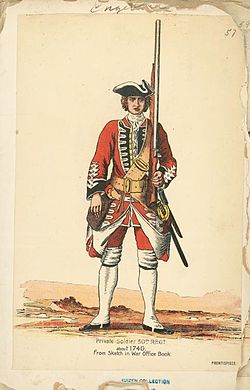- 50th (Queen's Own) Regiment of Foot
-
For other units with the same regimental number, see 50th Regiment of Foot (disambiguation).
The 50th (Queen's Own) Regiment of Foot was an infantry regiment of the British Army from 1755 to 1881.
The regiment was originally raised as the 52nd Regiment of Foot, but was renumbered in 1757 following the disbandment of the existing 50th and 51st regiments. It spent most of the Seven Years' War in England, raiding the French coast in 1757 and fighting in Germany in 1760, where it saw action at the Battle of Warburg, the Battle of Vellingshausen, and the Battle of Wilhelmsthal.
The regiment was posted to Jamaica in 1772, and then to New York in 1776. At this point, troops were transferred to other regiments and the officers returned to England to raise a new force; as such, the regiment did not see action in the American Revolutionary War. In 1778, they saw action serving on various ships of the Royal Navy as marines, including at the First Battle of Ushant. In 1782, they changed their name to the 50th (West Kent) Regiment of Foot.
During the Napoleonic Wars, the regiment saw action in Egypt, in Denmark, and in the Peninsular War, including the Battle of Corunna. A second battalion was raised, serving from 1804 to 1814; it saw action at Walcheren, as did the first battalion.
After a battle in the Peninsular War, the regiment was nicknamed the Dirty Half-Hundred; the regiment had worn uniforms with black facings, and when they wiped sweat away with their cuffs the dye stained their faces. (Half-hundred is a play on "fifty")
In 1827 they were retitled 50th (Duke of Clarence's) Regiment of Foot, in honour of the future William IV of the United Kingdom, and then as the 50th (Queen's Own) Regiment of Foot in 1831 in honour of William's wife, Queen Adelaide.
They travelled to Australia in detachments in the 1830s as escorts to prisoners, and then to India in 1841. They fought in the Gwalior campaign in 1843, and were in the thick of all four battles throughout the First Anglo-Sikh War in 1845–1846, taking heavy casualties and losing a large majority of officers. The regiment returned to England soon after. In 1854 they were based in Malta, and moved to the Crimea when the Crimean War broke out. The regiment fought at the Battle of Alma, the Battle of Inkerman, and in the Siege of Sevastopol.
In the 1860s they were once more in Australia and New Zealand, fighting in the New Zealand land wars in 1864.
In 1881, they amalgamated with the 97th (Earl of Ulster's) Regiment of Foot to form The Queen's Own (Royal West Kent Regiment). 2010 Some of these soldiers remains are in the cemetery at Sutton Forest in New South Wales.
References
Categories:- Infantry regiments of the British Army
- Military units and formations established in 1755
- Military units and formations of the United Kingdom in the Peninsular War
- Military units and formations disestablished in 1881
Wikimedia Foundation. 2010.

